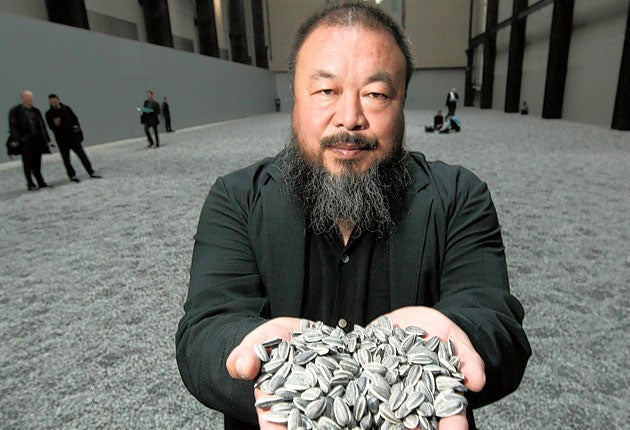Dust-up at Tate Modern as curse of Turbine Hall strikes again

Your support helps us to tell the story
From reproductive rights to climate change to Big Tech, The Independent is on the ground when the story is developing. Whether it's investigating the financials of Elon Musk's pro-Trump PAC or producing our latest documentary, 'The A Word', which shines a light on the American women fighting for reproductive rights, we know how important it is to parse out the facts from the messaging.
At such a critical moment in US history, we need reporters on the ground. Your donation allows us to keep sending journalists to speak to both sides of the story.
The Independent is trusted by Americans across the entire political spectrum. And unlike many other quality news outlets, we choose not to lock Americans out of our reporting and analysis with paywalls. We believe quality journalism should be available to everyone, paid for by those who can afford it.
Your support makes all the difference.When he unveiled his monumental installation at the Tate Modern earlier this week, Ai Weiwei enthused about how he wanted visitors to immerse themselves in his 100-million porcelain sunflower seeds, by putting the painted kernels into their mouths or building sandcastles if they so desired.
Now they will have to settle for gazing at the grey mass from afar after the latest installation at the Tubine Hall fell foul of health and safety warnings prompting managers of the world's most popular modern art museum to close the exhibit due to the hazardous dust being generated by thousands of art lovers tramping over the 150 tonnes of twice-baked clay – just as its Chinese creator had intended.
Tate officials said they had been "advised" that the dust could be dangerous if inhaled over a long period, and therefore the thoroughly interactive installation, which had seen visitors wallowing in the seeds while listening to their iPods, was returned to the more traditional "look but don't loll" school of art appreciation.
Yesterday, unimpressed art devotees, many of whom had travelled to London's South Bank specifically to indulge in the creation, were only being allowed to view it from behind a cordon . Small bowls of seeds were provided so visitors could still touch them.
With the sort of timing that would make even the most seasoned PR professional break out in a cold sweat, the announcement coincided with the unveiling by the Government of its proposals to end "senseless" health and safety regulations and create a new system of rules which it said would "treat adults like adults".
A Tate spokeswoman said: "Although porcelain is very robust, the enthusiastic interaction of visitors has resulted in a greater than expected level of dust in the Turbine Hall. Tate has been advised that this dust could be damaging to health following repeated inhalation over a long period of time. In consequence, Tate, in consultation with the artist, has decided not to allow visitors to walk across the sculpture."
The Sunflower Seeds installation was unveiled on Monday to considerable critical acclaim by Weiwei, an outspoken artist in his native China who oversaw the creation over two years of the porcelain husks by craftsmen in the city of Jingdezhen, famed for its Imperial pottery. Each seed was hand-sculpted, kiln-fired and then hand-painted by an army of 1,600 workers based in artisanal studios, before being fired once more and polished.
Visitors flocked to the 1,000-square metre exhibit with more than 14,000 members of the public stomping over the china seeds on Tuesday, the first day it was fully open. But by Thursday afternoon it was clear that all was not well, with staff initially saying the installation was closed for maintenance before announcing the permanent closure yesterday.
It was the sheer volume of seed lovers which landed the Tate with its problem, as the footfall caused minute particles of the paint on the kernels and the clay to break off. It is understood that managers were concerned the installation would not last the six months of its intended display period. Their cautious approach is perhaps understandable given that it is not the first time the enthusiastic participation of visitors has forced the Tate to reconsider its installations. In 1971, a set of interactive tunnels and ramps at the original Tate Gallery by Robert Morris had to be closed after four days because too many people were being injured.
More recently, the Tate Modern has paid out nearly £27,000 in compensation for injuries to six visitors, including at least two who were injured on previous installations in the Turbine Hall, including the set of vertiginous slides installed in 2006. Tate officials said Weiwei, 52, who had described the quantity of seeds as "beyond imagination", still felt his sculpture could be experienced by looking as much as touching.
Art with a health warning
Test Site, 2006
Dane Carsten Holler's installation of slides caused several injuries despite efforts to provide guidance and safety rules. A 63-year-old charity worker was paid £3,500 for a hand injury.
Shibboleth, 2007
Tate managers considered covering the 167-metre crack in the Turbine Hall floor in perspex after 15 people were hurt falling inside Doris Salcedo's work, designed to higlight racial division.
How It Is, 2009
The pitch-black box by Polish artist Miroslaw Balka claimed a victim on its first day when a visitor emerged with a lump on his nose and blood on his suit after apparently walking into a wall.
Sunflower Seeds, 2010
Chinese artist Ai Wei Wei's sea of porcelain "seeds" was closed off yesterday after trampling visitors kicked up potentially hazardous dust.
Join our commenting forum
Join thought-provoking conversations, follow other Independent readers and see their replies
Comments